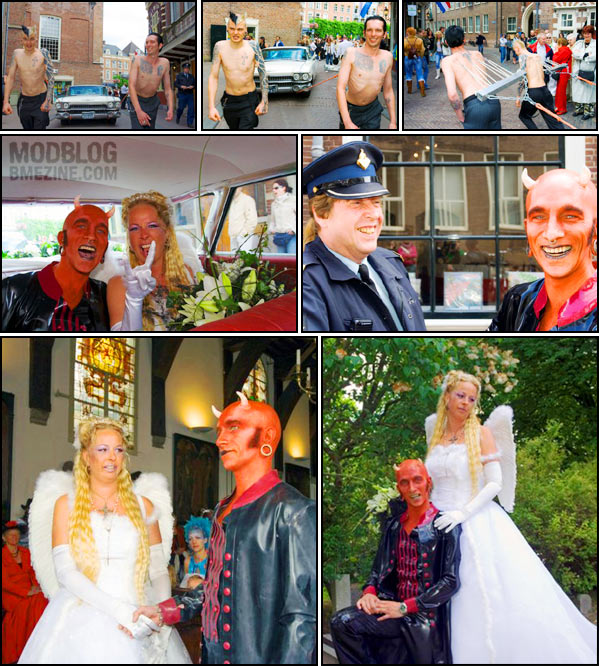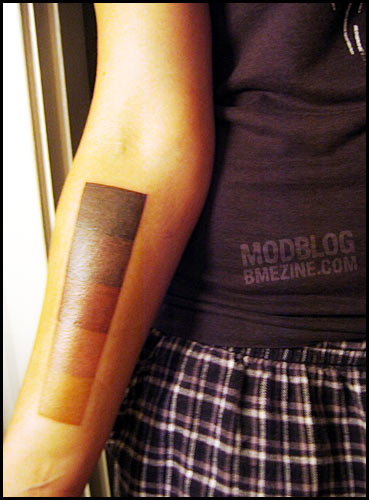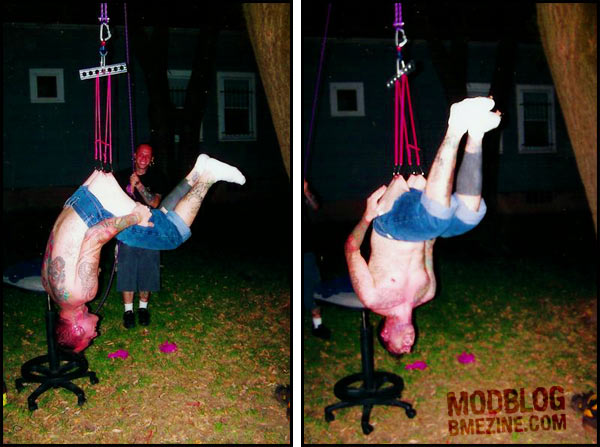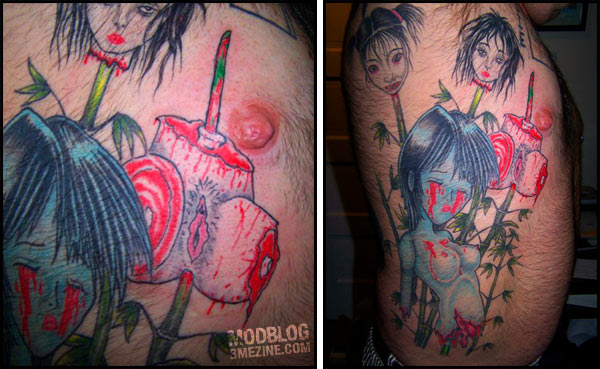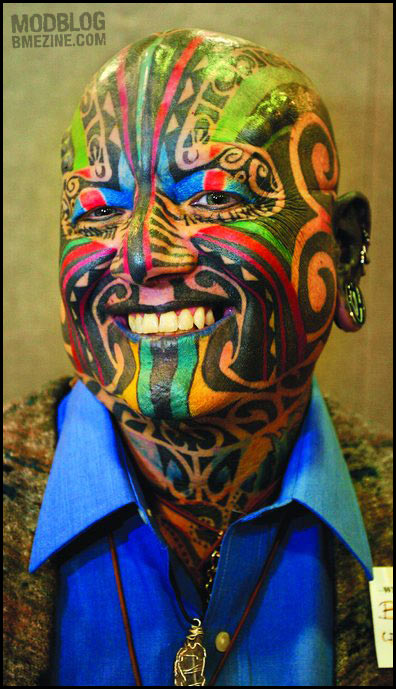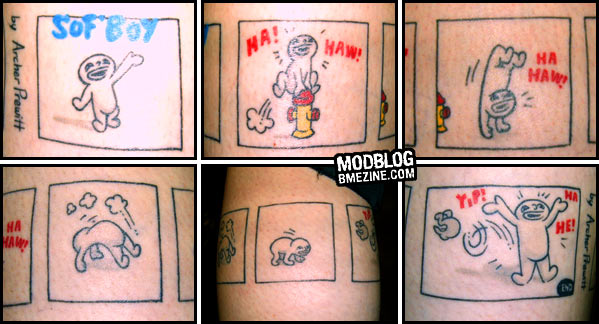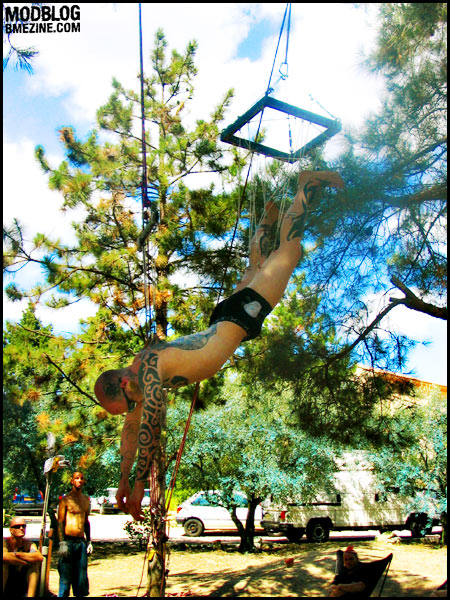Sometimes it’s hard to track down the original source of an article because until relatively recently, we didn’t have draconian copyright laws, and newspapers regularly copied each other. This one comes from The Washington Post (November 4, 1885), and they say they got it from “a New York Paper”, and I suspect that newspaper took it from a Boston-based one. Anyway, let’s begin:
It is a tiny shop, wedged between two loftier buildings. A door and one broad window, shaded by a scarlet curtain, comprises the entire front. Within, a rear apartment is formed by a curtain composed of the Stars and Stripes. The furniture is plain and simple. The occupant is a young man with a pleasant face. His arms are bared to the elbows, and bear evidence of his skill in a variety of figures, patriotic, mythological, and miscellaneous, “All I can well attend to,” said Mr. Getchell, the artist, when asked whether the demand for his labor is large. “You would be surprised to know how many difference classes of people call upon me to have tattooing done.”
“Sailors and boys chiefly,” was suggested.
“I have a great many of them, of course, but I cannot say that they are my chief customers. I tattoo a great many commercial travelers, who wish a small mark upon their bodies in case of accident. Then ladies and children form a large proportion of my customers. A great many parents bring their children to be marked for identification in case of loss or kidnapping. Children I almost invariably mark on the left leg, just above the ankle. I usually put on some small distinguishing mark, such as a star, an anchor, a strawberry or often a simple dot.”
“Is the process painful?” was asked.
“By no means. The design is first drawn on the skin in India ink, or vermillion; then it is lightly pricked in with needles. The other day a gentleman came in, bringing two little twin boys, about a year and a half old. They were dressed just alike, and they were as similar in every respect as two white beans.
“‘I want one of these chaps marked, so I can tell them apart,’ said the father.
“‘Don’t they know their names?’ I asked.
“‘If they do they both answer to the same name. If I call “Johnnie” they both answer, or if I call “Willie” they both answer, too. That breaks me all up, and I want one of them marked, so I can tell one from the other. I don’t care which one of them you take, only mark one of the quick.’
“So I took one of the little chaps on my knee and pricked a little dot on his left hand, on the space between the thumb and first finger. The boy looked on with great wonderment, but didn’t utter a cry, and went off with his father, looking at his hand.”
“You have many lady customers, you say?”
“Yes, a great many. I had a call from a woman once, who wished to be tattooed from head to foot for exhibition purposes, but I refused to do it. I frequently have calls from ladies who wish some small mark for the purpose of identification in case of accident. Often they dislike to have a mark put upon the arm, especially society ladies. In such cases I frequently mark the shoulder, where the mark will be concealed, even when in full dress. But I have very frequently put the initials, and sometimes the full name, upon the fleshy part of the upper arm.”
“It is said that ladies often have the initials or monograms of their lovers placed upon their arms?” was suggested.
“Oh, frequently! They come in their carriages and have it done. Once I put the words ‘Dear Harry’ on a young lady’s arm.”
“Do they ever come afterward and wish it erased or changed?”
“Oh, often. I had a curious case once. A very pretty and stylish young lady came here in a Herdic cab. She said she had left her carriage standing near the Public Garden and had taken the Herdic to avoid notice. She wanted the initial ‘P’ in a fancy letter placed upon the top of her shoulder.
“‘You see,’ she explained, ‘P stands for Paul, the—the gentleman whom I—I am to marry. I don’t want it where it will show, of course; but put it just where the shoulder band will cover it when I am in full dress. Make it blue, shaded with red.’
“She screamed a little when the needle made the first price, but she soon discovered that the pain was insignificant, and the work was soon done to her satisfaction.
“‘How pleased he will be,’ she said, when it was over. ‘But he shan’t see it until after we are married,’ she added, as she went out.
“A few months afterward a Herdic stopped at the door, and the same lady alighted and entered. ‘You see,’ she explained, with a very slight blush, ‘that the gentleman whose initial you put on my shoulder doesn’t—doesn’t come any more, and I want it changed. Do you think—do you think you could change it to a B?’
“‘Oh, yes,’ said I; ‘that can be done very easily.’
“‘You see, this gentleman’s name is Bashford, and I thought you could change it easily.’
“So I changed the P to a B, and put on a few flourishes, and she left. I thought I had seen the last of her, until a few months ago she came again, and blushed in earnest.
“‘Well,’ said I laughing, ‘must I change it again? What is his name now?’
“‘His name is Mortimer, and oh, we are to be married next week and my dress and veil are all done and I am afraid of making him angry, for he knows nothing of the others. Do you think you could change the B to an M.’
“‘That would be impossible,’ said I, ‘but I can cover the latter over with some other design if you like that.’
“‘No, I shouldn’t like that. It wouldn’t mean anything,’ she said, looking almost ready to cry. Then suddenly she looked up and cried out: ‘Oh, I have it. I just done on Beethoven and so does he. I’ll let the B stand for Beethoven and you shall put on the first two measures of his sonata in A minor. Won’t that be nice?’
“Seizing a pencil, she marked a staff and a few notes of music on a scrap of paper, and handed it to me. I sketched on her shoulder a scroll bearing the initial B in the center, and then drew in the staff and notes as she had indicated. It was quite a nice job, but she was very patient, and finally went away smiling and humming the air which I had tattooed on her shoulder.”
“Did you ever see her again?”
“A few days later I chanced to be in the Boston and Albany Depot, when a lady and gentleman passed me, going toward the train. She had the look of a bride, and as they passed me she gave me a glance and hummed the air that I had scratched upon her shoulder.”
I don’t know about you, but this is one of my favorite old tattoo stories I’ve dug up yet…
